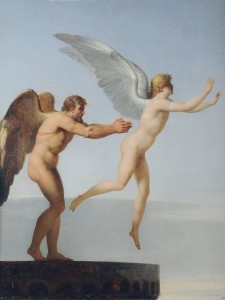In Greek mythology, Icarus (Icarus) is the son of the architect Labyrinth, builder of the Cretan labyrinth, and of a slave named Naucrate. Icarus was imprisoned with his father on the island by King Minos, to prevent him from escaping and revealing the secret of the labyrinth.
 Daedalus and his son Icarus could not escape the island by sea as the king kept a close watch on all sailing ships, and did not allow any to sail without being carefully searched. Since King Minos controlled the land and the sea, Daedalus began making wings for himself and others for his son.
Daedalus and his son Icarus could not escape the island by sea as the king kept a close watch on all sailing ships, and did not allow any to sail without being carefully searched. Since King Minos controlled the land and the sea, Daedalus began making wings for himself and others for his son.
When he finally finished his work, Daedalus flapped his wings and found himself suspended in the air. He taught his son to fly like this and when they were both ready, Daedalus warned his son not to fly too high, because the Sun could melt the wax on the wings, nor too low because the sea foam would wet the feathers of the wings and he would not be able to fly. fly.
The boy, captivated by the beauty of flight and forgetting his father's warnings, ascended too high. The burning Sun softened the wax on his wings, thus losing his feathers, precipitating him into the void.
In Villa Radieuse, another architect, Charles-Édouard Jeanneret-Gris, better known as Le Carbousier, he claimed: "The daily adventure of nature in its life cycle obeys a fundamental law of our earth, the law of the Sun, which is the great dictator." The star that provides life does not forgive man's challenge.
But the image of Icarus continued to live on, inspiring inventors. In the Renaissance, Leonardo da Vinci (1452-1519) created the principle of the airplane and the helicopter. Much later, in the 19th century, the discovery of the airplane began to take shape.
Every concave angle has a corresponding convex angle. The shapes can cut out the space according to their movements.
The myth of Icarus addresses themes such as man's desire to always go further, even at the risk of having to come face to face with his condition as a simple human being.
